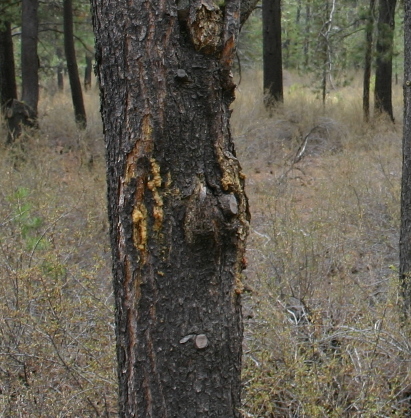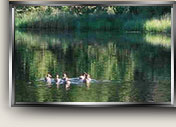Forest Issues and Challenges
The primary objective for the forest is to keep
it healthy and attractive. The secondary objective is to
maintain screening from South Century Boulevard and from our
neighbors, primarily from Oregon Water Wonderland. While the ranch
makes some use of forest products (e.g. wood chips for trails and
paddocks, tree trunks and branches for fence rails, firewood, house
logs, and furniture), the ranch does not manage the forest for these
uses or to sell timber commercially.
The greatest threat to the forests is a
catastrophic wildfire. Secondary threats include surface-level
fires, insect damage, and disease.
If left to nature, lightning would start a low
level surface fire about every twenty years. Every hundred years or
so, a major “crown” fire would burn and kill virtually all the trees
on the ranch. The forest around us has burned and regenerated
itself hundreds of times. The intent of the ranch is to manage the
forest so that no serious fire can get started or spread on the
ranch. While the ranch has made significant progress, it has a long
way to go to achieve this goal.
Types of Fire
A surface fire burns fuels on the forest
floor, like twigs, dead branches, leaf litter, and grass. At
Vandevert, the very combustible bitterbrush is a primary fuel for
ground fire. Surface fires generally move quickly but rarely
generate a great deal of heat or do long-lasting damage. In
wilderness areas surface fires are often beneficial because they keep
the fuel on the ground from accumulating.
A ground fire burns the decaying plant
matter (duff) that lies at the surface or just below the surface of
the ground. In dry periods these fires can smolder for weeks and
can be very difficult to extinguish. But they spread slowly and do
little visible damage. Ground fires are not likely to be a problem
on the ranch because the duff on the ranch is only 2-3 inches deep.
Where ground fires have occurred in the Cascades, the duff was over
two feet deep. It will take many years for more duff to accumulate
and it can be periodically reduced.
A crown fire engages tree branches and
leaves that are more than six feet above the ground (so-called
“aerial fuels”). A crown fire generates a great deal of heat and
can move very quickly through the canopy of a forest. It can
inflict heavy damage that will be visible for many years afterward.
In a “blowup” a crown fire erupt suddenly into a “firestorm” that
creates its own draft (wind). A firestorm can jump rivers and fire
lines by carrying burning debris far beyond the leading edge of the
fire.
Guarding Against Fire Damage
The ranch cannot prevent lightning from
starting a fire on the property or prevent a fire started elsewhere
from reaching the ranch. But the ranch can limit the spread of fire
and the damage a fire can do through a targeted “fuels reduction”
program and the creation of “shaded fuel breaks”.
A fuel break is a space in the forest
where the amount of fuel available to burn is sharply reduced. Fuel
breaks provide a good place to stop a forest fire, particularly a
crown fire, from spreading. In commercial forests fuel breaks are
often created by clear cutting (removing all trees and brush of all
sizes). A shaded fuel break leaves the best trees in
place but reduces fuels and slows the spread of fire. A shaded
fuel break is created by removing dead and down wood, reducing
“ladder fuels” (including brush), and thinning.
Pre-commercial thinning is
like creating a shaded fuel break except that it doesn't remove
brush (e.g. bitterbrush). Pre-commercial thinning supports
healthy trees and produces essentially the same quality of timber as
creating a shaded fuel break. But pre-commercial thinning does
not go as far in reducing the risk of fire.
Removal of Dead and Down Wood – Dead
trees and branches, whether standing or lying on the ground, provide
easily ignitable fuel for fire. They also support the spread of
insects, fungus, and diseases. In accord with the
state Forest Practices Act the ranch removes most of this wood but leaves some of the older
material
on the forest floor to provide habitat for salamanders and other
creatures
Ladder Fuels Reduction –
Ladder fuels allow surface fires to climb into the branches of trees
and from there to the tree crowns. Reduction includes the
cutting of shrubs, especially bitter brush, and the pruning of the
lower branches of trees. The flames from a three-foot high
bitterbrush can rise like a torch up to nine feet high.
Thinning – Lodgepoles are especially
inclined to grow close together in dense groups. Increasing the
space between tree trunks to 10 to 12 feet (14 or 15 feet in shaded
fuel breaks) yields stronger and
healthier trees, gives surface fires fewer trees to climb into, and
makes it more difficult for fire to spread from tree to tree.
Thinning and Fuels Reduction Past and Present
In 1998, pre-commercial thinning was done on the entire forest
immediately west of South Century Boulevard (i.e. Stands II and
III). Thinning was repeated on Stand III (south of the
main ranch entrance) in 2003.
In 2007, a 200 foot wide shaded fuels break was
created along the border of the ranch in the stands south and north
of the pasture (Stands V and VI). This was done in conjunction with
the La Pine High
School Forestry Program as described in the Appendices to the
Stewardship Plan.
Plans for 2008 include creating a shaded fuels
break east of South Century (Stand I) and continuing the shaded
fuels break along the western border (Stands VI and VII). Thinning in 2007 and 2008 was
largely funded by a federal Wildland Urban Interface (WUI) grant
administered by the Oregon Department of Forestry.
Important Pests and Diseases
A forest of healthy trees can resist most pests
and diseases. But forests weakened by one problem become more
vulnerable to many others – and to the threat of fire. After fire
itself, the four biggest threats to the Vandevert forests are these:
Mountain Pine Beetle - Adult beetles
bore into the tree, excavate tunnels under the bark, and lay their
eggs in the tunnels. The larva, when they hatch, eat the phloem and
xylem tissues that carry water and nutrients up and down the tree,
sometimes girdling the tree and cutting off the flow altogether.
Healthy trees flood the tunnels with sap and resin, drowning the
adult beetles before they lay their eggs. But trees that are
overcrowded or past maturity may not generate enough sap to deter
the pests. The beetles prefer lodgepoles and normally attack ponderosas only
when they are immediately adjacent to lodgepoles the beetles have
already infested.
In addition to keeping trees thinned and
healthy, the key to defending the forest against pine beetles is to
promptly remove any trees with a significant beetle infestation.
Creamy white or pink "pitch tubes" with dust like sawdust in them
appear on trees when the beetles begin tunneling. Infested
trees should removed in June of each year before the adult beetles
emerge to search out new trees to attack. Reducing the number
of beetles in the forest this way means the healthy trees will have
fewer beetles to defend against.
 Western Gall Rust – This fungal
infection creates round swellings (galls) on branches and trunks of
trees, especially lodgepoles and ponderosas. Insects and
other fungi attack galled tissue, killing branches and small stems.
Galls weaken stems of large trees, especially by forming hip
cankers (see photo at right), and make trees susceptible to windsnap (breaking in the
wind).
Western Gall Rust – This fungal
infection creates round swellings (galls) on branches and trunks of
trees, especially lodgepoles and ponderosas. Insects and
other fungi attack galled tissue, killing branches and small stems.
Galls weaken stems of large trees, especially by forming hip
cankers (see photo at right), and make trees susceptible to windsnap (breaking in the
wind).
Dwarf Mistletoe - Dwarf mistletoes are
small, leafless, parasitic flowering plants that extend their roots
into the youngest branches of both lodgepoles and ponderosas. They
kill a tree slowly by robbing it of food and water. Diseased trees
decline and die from the top down as lower infected branches take
more food and water. The problem is serious in commercial forests
because it slows the growth of the tree. It is less of a problem
for the ranch because the tree remains green for a very long time.
The parasite can be controlled by targeting
affected trees and branches during thinning. By increasing the
distance between trees, thinning itself slows the spread of the
mistletoe.
Heart Rot - Heart rot is a brown fungus
that eats away the heart of relatively mature trees. While heart
rot is important in the timber industry (accounting for over 70% of
timber losses due to disease) it is less important to the ranch
because the tree continues to look healthy while the disease
progresses. The downside is the tree may be more vulnerable to
windsnap and insects. Heart rot is essentially a disease of old age
(80 to 100 years in a lodgepole, well over 200 years in a
ponderosa). It is generally not contagious. The first indication
that a tree is dying of heart rot is a profusion of cones. The only
remedy is to remove the mature trees and thereby allow younger trees
to grow more rapidly.
Less Significant Pests and Diseases
While tree bark is the principal food of
porcupines, there are not many porcupines on the ranch. Squirrels
do far more damage and can kill a tree if they girdle it. Gophers
are a serious threat to seedlings. Beavers eat willows and use them
to build their lodges. But the willows generally regenerate faster
than the beavers can destroy them.
The sequoia pitch moth has appeared on the
ranch but its effect is minor. The western pine beetle, which
attacks ponderosas, has not been seen on the ranch so far.
Wood-boring insects are another serious threat to the value of
lumber but less of a concern to the ranch because they are very slow
to kill the tree. Insects which have not been significant problems
also include: defoliators (e.g. caterpillars, webworms, sawflies,
tussock moths), root-feeding insects (e.g. weevils and the larvae of
click beetles, May beetles, and June beetles), terminal-feeding
insects (e.g. pine tip moth, white pine weevil), and sucking insects
(aphids, mites, cicadas, and others).
The incidence of blister rust has not been
severe. Root rot and white rot have not been significant problems.
While trees can be stressed in hot dry summers,
the high water table on the ranch reduces the damage that drought
can do.
Pest Management
“Integrated Pest Management” is a modern
approach to controlling harmful insects and protecting useful
insects. It combines mechanical control, chemical control,
biological control, and genetically engineered plant resistance to
insects. The objective is not to totally eliminate harmful insects
but to keep their populations low enough to minimize insect damage.
The ranch has been successful to date using
mechanical means alone. The removal of dead, diseased, and infested
wood has been sufficient to prevent any significant insect damage.
Other approaches can and will be employed if they are needed.
Cooperation with Neighbors
Vandevert Ranch has joined with
seventeen
other communities in the Upper Deschutes River Coalition to restore
and sustain healthy fire-resistant forests, pure and abundant river
flows, and wildlife habitat. Of 13,210 acres in local private
lands, 4,360 have been thinned for fuels reduction and another 1,453
are due to be thinned. This effort has made all the communities in
the area safer from the spread of wildfire.
Continue to Government Impact on
Forestlands
Return to
Stewardship Plan Table of Contents






